- Home
- Encyclopedia
- The Wyoming State Flag and The Women Who Made I...
The Wyoming State Flag and the Women Who Made It Fly
A few people in Wyoming know the secret behind their beloved state flag. They will give a knowing smile, perhaps a chuckle, as they nod, yes—that bison wasn’t always hitched to the staff, he used to look out over the mountains and prairie. The Wyoming State Flag holds more secrets in its weave; the bison himself tells of the complicated relationship between the two women who made him fly, Grace Raymond Hebard and Verna Keays Keyes.
A $20 competition
Around the first week of September 1916, notices began appearing in newspapers across the state advertising a $20 cash prize for the best design of a Wyoming State Flag, to be chosen by the members of the Daughters of the American Revolution. After 26 years of statehood, Wyoming still did not have a flag, and serving as the state regent for D.A.R., Grace Raymond Hebard was determined to have one introduced during the 1917 legislative session. Hebard was a cartographer during Wyoming’s territorial days and after statehood served as deputy state engineer and held numerous positions at the University of Wyoming, from secretary of the Board of Trustees to professor of political economy. Hebard’s work ethic along with her influential positions enabled her to pursue her vision of Wyoming.
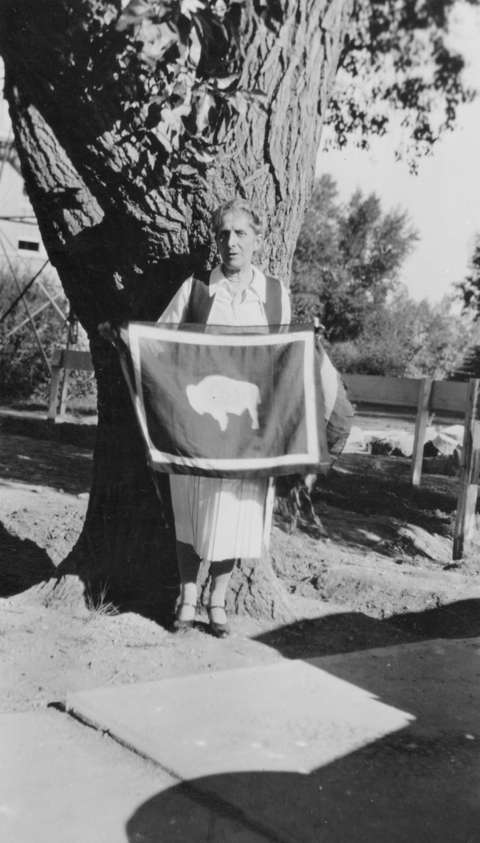
Projects during her two-year term as state D.A.R. regent included securing public and private funding for the marking of historic trails and forts, and, in her final year, she set her sights on the state flag and flower. The 1916 competition was clearly organized by Hebard, with all entries to be postmarked to her address in Laramie no later than September 30th.
The September call for flag designs caught the attention of Wilbur “Billy” Parke Keays, a civic leader and entrepreneur in Buffalo, Wyo., who knew the perfect woman for the job: his young, talented daughter, Verna. Returning home to Buffalo on July 8, 1916, as Wyoming’s first graduate of the Art Institute of Chicago, Verna was already a successful designer. Earlier that year, newspapers in her hometown celebrated her winning interior design of a Pullman Dining Car in a competition hosted by the Chicago, Burlington, and Quincy Railroad. Billy was now eager to see his daughter win a prize closer to home.
Recalling the summer of 1916, Verna later wrote about procrastinating with a school friend, Ann Wood, visiting from Cleveland, Ohio, who “made an excellent excuse for me to do everything but draw.” A gregarious and outgoing young woman, Verna often surrounded herself with friends for excursions in the Bighorn Mountains or short jaunts to Sheridan, Wyo.. Still, the summer of 1916 wasn’t just fun with friends. Verna displayed a civic spirit similar to her parents’ by advocating for art instruction in Wyoming schools at the 1916 annual Teachers’ Institute. Verna argued to teachers from Johnson and Campbell counties that art instruction was “not a luxury, but a necessity in the life of every pupil,” while also teaching several basic art and design principles she learned while studying in Chicago.
As the deadline for the competition drew near and her “father’s persuasion increased,” Verna knew she needed to put paint to paper. Still the perfect design eluded her until late one night she woke from a sound sleep. For the rest of her life, Verna would recall this as a moment of divine inspiration, causing such excitement she woke her friend up. The next morning Verna drew the design revealed to her in the night: a white silhouette of a bison looking out, branded with the Great Seal and set on a field of blue, with a white border stripe inside another of red.
On Oct. 4, 1916, at 4 p.m., the biennial D.A.R. Conference opened with a patriotic song before conducting regular business. During her report of her time as state regent, Hebard told of the motivation behind her wish to introduce a flag: She wanted to have a state flag the Wyoming National Guard could carry if they were sent off to battle. Tensions with Mexicoand the anxiety of the United States being drawn into the Great War motivated Hebard along with many others across the U.S. to push for their states to claim a flag. Hebard hoped the flag chosen by D.A.R. would also serve as a “lasting memorial” to their patriotic organization.
Among the flags put in front of the women of D.A.R. was one designed by Hebard, featuring the Great Seal. It appears that Hebard removed the names from each submission to ensure that the best design would win, rather than the most well-known or well-liked designer. Instead, the Wyoming State Flag was chosen for its design alone, allowing for Verna Keays’s talent and divine inspiration to shine. Verna would later recall, “I was … delighted, of course, when the late Dr. Grace Raymond Hebard phoned to tell me that the design which I had entered had won. It was an honor, but how great, I did not begin to realize until some years later.” With her $20 prize in hand, Verna also likely did not realize that soon her communications with Hebard would grow to much more than a single congratulatory phone call.
The winning design becomes law
In the following months, Hebard circulated Verna’s design around the state, gaining approval from educators and legislators. Hebard then prepared a description of Verna’s design for State Sen. William W. Daley of Carbon County, who sponsored the bill. Hebard’s technical description would become the statute, a simple law giving the specific colors and measurements for the borders, the Great Seal, and the “buffalo” as Hebard unwaveringly called the bison on the flag.
Absent from Hebard’s technical description and the statute today is a description of which direction the bison should face. Absent as well are specifications for which version of the Great Seal is to be used, and where exactly it should be exactly positioned on the bison silhouette. Also unspecified is whether the bison should precisely match Verna's 1917 design. If the legislators of Wyoming saw an image of the state flag before their vote, it would have been Verna’s original painting, with the bison facing out as though to look over the mountains and prairies of Wyoming, symbolizing freedom.
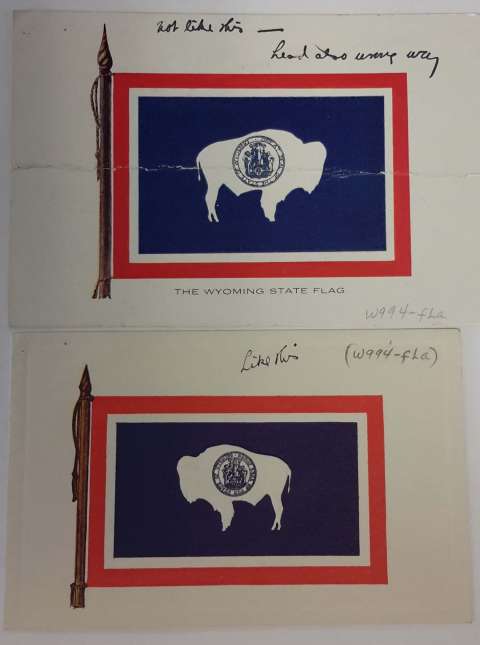
Twenty-six days before the State Flag bill was signed into law by Gov. John B. Kendrick at 1:27 p.m. on Jan. 31, 1917, Verna received exclusive manufacturing rights to her design from the George Lauterer Company in Chicago. Confident that her flag would pass into law, Verna focused on securing the future of her design and her future as a designer. That winter Buffalo newspapers advertised Verna’s new business, “Distinctive Designs,” offering holiday and interior decorations. Displaying an entrepreneurial spirit instilled in her from childhood, Verna designed name plates and decorations for many of the social events in Buffalo the same year her design was signed into law as the official Wyoming State Flag.
The first Wyoming state flags
Afterward, Verna continued working independently on having the new flag manufactured. If the Lauterer Company delivered on time, Verna could have had the first flags as early as February, just days after her design was signed into law. The size of these flags is not mentioned in any known correspondence between Verna and Grace in their correspondence now at the American Heritage Center at the University of Wyoming, but Verna’s earliest saved quote from the Lauterer Company suggests that she was purchasing quantities of small felt or silk flags. These could have been small as a postcard or large as a ledger and were priced by the hundred lot.
Hebard shared Verna’s eagerness to see Wyoming state flags produced and put before the people of the state as quickly as possible. Only a few years prior, the D.A.R. of Colorado discovered that their 1910 design competition for a state flag did not give Colorado its first flag, but rather replaced a forgotten flag that had been signed into law but never mass produced.
The power of a flag does not come from a piece of paper signed by a governor but from the people who the flag is meant to represent. In May 1917, Hebard wrote to John T. Hawkes, principal of Buffalo High School, “We should get the flag and the flower before the people of the State in order to familiarize them with them and also defend them as I understand that some people are already criticising [sic] the selection of the State Flower.”
While Verna secured a manufacturer in Chicago, Hebard and Edith K.O. Clark, the state school superintendent, struggled to find any suitable manufacturer for the new flag. Both members of D.A.R., they wished to have two honorary flags made to be given to Sen. Daley and Gov. Kendrick. Hebard explained, “We have had several companies submit us a Flag, thinking they would follow the designs, but the Buffalo's head looked like a sack of flour and his body like that of a sack of wheat. We absolutely rejected several flags because the design was not carried out and the colors were not properly exercised.” Clark’s diary from 1917 notes that on April 17 she ordered 1750 postal cards of the State Flag and Flower from a Cheyenne printer, but makes no other special mention of her difficulty in producing a suitable flag.
By May 1917, the women had turned to Keays for help, with Hebard writing “I do not think that anyone is better qualified to take up this matter than Miss Keays and to accept no Flag unless it is absolutely worthy of the designer.”
Despite their shared determination to produce flags as quickly as possible, when the United States entered World War I in early April 1917, the production on the full sized flags stalled. Hebard dedicated her time and finances to the war cause, raising money for the Fourth Liberty Loan as a Four-Minute Man and even requesting permission to let her D.A.R. membership lapse. Verna likewise volunteered her time to the war effort.
Though production on the full size flag had slowed, the flag still became a portable piece of home to many of the men stationed at Fort Warren, thanks to Major Edward Marsh Turner, M.D. Turner ensured that every member of the Wyoming National Guard Medical Corps received a hand-sized silk Wyoming Flag before deploying to France. The fragile cut of silk carried to the front lines of war featured a reprint of Verna’s winning design including the decorative staff and the bison facing out.
A change in direction
After Hebard’s May 1917 letter, the two women apparently did not save any further correspondence until May 1918. The archived correspondence between Verna and Hebard hints at many more letters now lost. Somewhere in these lost letters Hebard first instructed Verna to turn her bison’s nose into the wind. Hebard wrote her preference on a post card that is now in Verna’s collection at the American Heritage Center. Apparently the card was mailed with a letter that she did not save.
It is easy to imagine Verna’s reaction to “not like this— head also wrong way,” in Hebard’s handwriting scribbled across her design. Verna’s 1949 letter explaining Hebard’s design change to State Historian Ellen Crowley shows Verna at her most candid, “When the first flags were made Dr. Hebard insisted the bison be turned toward the staff. ... It was Dr. Hebard’s wish and it was done, and few questioned or crossed her.” In 1918, Hebard was a force as powerful and unrelenting as the Wyoming wind—she had profoundly shaped the state through her work and earned a great deal of respect from her fellow Wyomingites—she was a strong enough force to turn that bison.
By Dec. 7, 1918, Hebard purchased the first two full-sized silk Wyoming flags from Verna who had them manufactured by the George Lauterer Company and apparently shipped directly to Hebard. Hebard opined to Verna, “I wish you might have seen how really beautiful the two Wyoming flags were! It would quite have delighted your artistic heart.” Hebard so approved of the flags that she immediately ordered a third from Verna to give to the incoming governor. Ordering this flag, Hebard asked Verna to not feel discouraged about the “marks in enclosed card [...] I wish they had more closely followed your artistic work.” Still, Hebard gave further notes on the design for the next flag.
On Feb. 15, 1919, Hebard presented this flag to Gov. Robert D. Carey in a ceremony before a joint session of the Legislature. In her short speech, Hebard credited Verna for her design, then mentioned her own patriotic motivations and finally advocated for the soldiers returning home from war in need of work. Carey accepted the flag, giving thanks to the D.A.R. and, according to the Laramie Republican, added “that the flag was a credit to Dr. Hebard, especially since the honor of the inspiration for its origin belonged to her.” Verna then spoke on her understanding of the symbolism of the flag’s design and colors. Next, Daley recounted the Senate floor debate, with each political party advocating a different animal emblem to replace the bison. But Verna's design emerged unscathed.
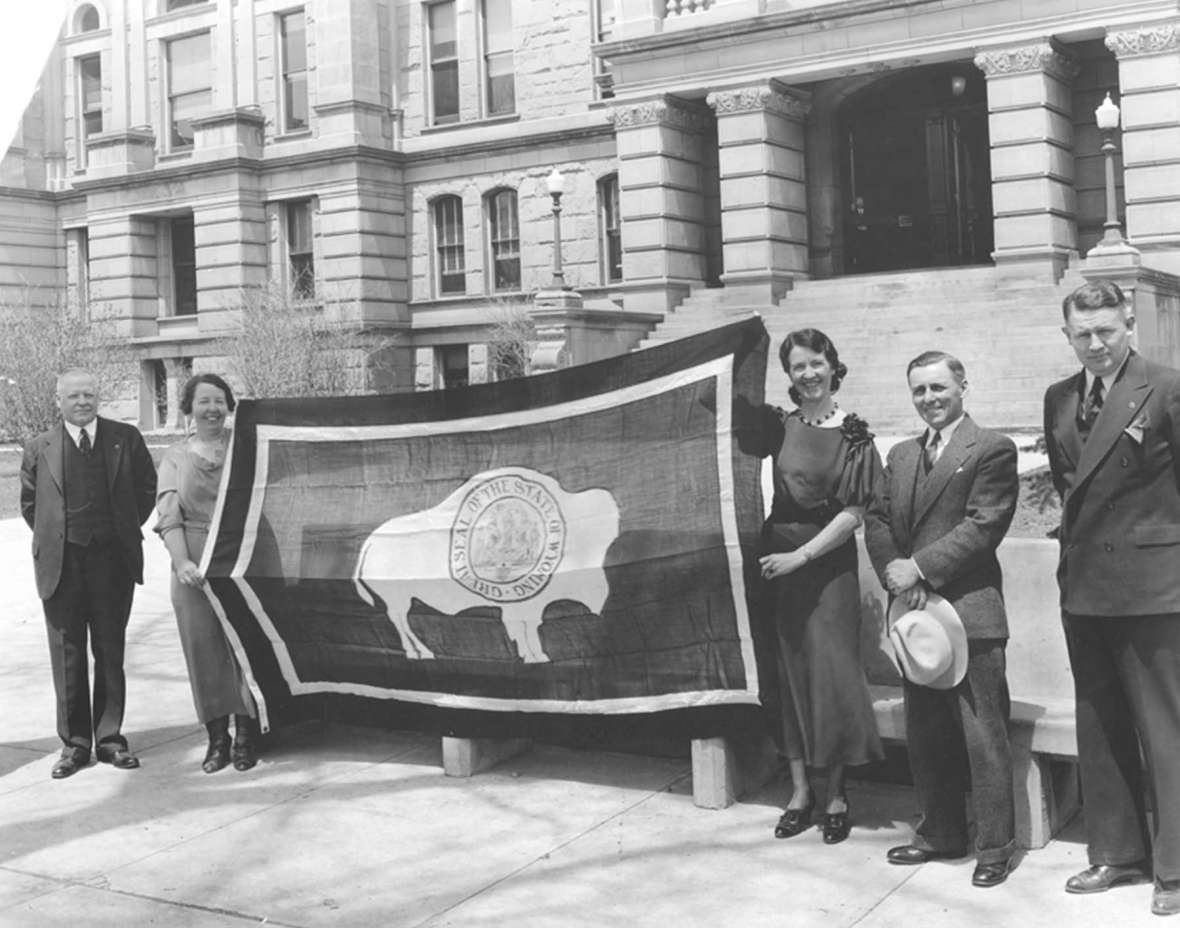
Mocking straight lines
Verna’s initial reaction to her design change can now only be found in the professional but gritted tone of her early correspondence with Hebard and one letter exchange with her friend Mina Carr after the February 1919 ceremony. Ten days after the ceremony, Hebard wrote to Verna about the appropriation set aside for a pamphlet on the flag. Badly mixed! ,” Verna then wrote to a friend in Cheyenne. “She just wanted us to know she reads the Cheyenne papers!”
While Verna was serving as a bill clerk for the Senate in 1919, it appears unlikely that she used her position to advocate or protest against specific bills. Hebard’s letter continued with further notice of the appropriation set aside for a pamphlet on the flag, “Of course, the drawing of the design will be left to you and I am wondering if in the outline of the Buffalo’s face could there not be a little forelock running down and not just one continuous straight line from the top of his ear to his mouth?” Verna wrote to her friend “Gracious! That’s Grace all over!!!” Hebard’s letter closed with compliments to Verna’s design and colors that took “everything by force.” Verna’s last quip, “Much to her surprise.”
Mina Carr responded in a mock Hebard tone, even signing her name “(Dr.) Mina Carr,” and stating that she had “been wondering” and listed the many continuous straight lines and the silly ways the “buffalo” could be adjusted from lifting one foot to winking “his right eye, sort of playfully, you know as if he were looking at Dr. Grace Hebard.” Mina Carr finished the letter in her best mock Hebard, “My dear Miss Keays, I would appreciate your making these changes, and feel sure you will be pleased at the general effect produced.”
But in a 1946 note Verna wrote when she donated her papers to the American Heritage Center at the University of Wyoming, she scolded herself for being “very disrespectful!” and stated that after so much correspondence concerning the design, this letter from Hebard seemed to be “particularly amusing. "Today," she added, "I would not do such a thing.”
Losing touch
Following the legislative pamphlet, the two women appear to have lost touch for a number of years. Verna continued to sell flags, including some to Gov. Carey in 1921. It is likely that some of these flags were as Verna originally designed with the bison facing away from the staff. Gov. Carey purchased a number of flags for $20, and noted that she was offering another hundred for $15, which he would purchase should he need more. It seems likely from the price that these flags were quite small and not made from silk. That same year, she married World War I Marine Corps veteran and entrepreneur Arthur Keyes, changing her last name from Keays to Keyes. The couple briefly moved to Montana where their first child was born, a daughter, Betty, in 1923. Soon they moved again to the bustling town of Casper, population around 14,000, where their second daughter, Priscilla, was born in in February 1925.
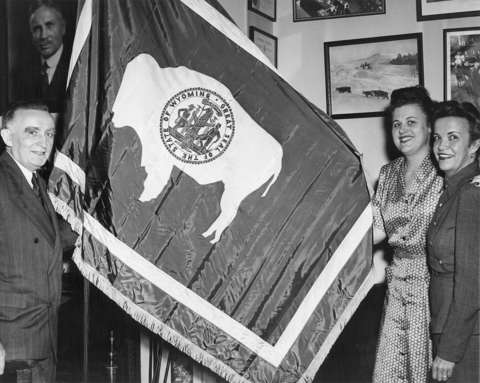
Hebard likewise continued to labor for the flag, enlisting the art department at University of Wyoming to produce a flag pattern which could be mailed out to every school in Wyoming as an activity for schoolchildren. She had intended to buy a flag from Verna to place in the library at the university, but the money collected from overdue book fines had gone to buy war bonds instead. Before the funds could be replenished, Hebard had stepped down as head librarian at the university and lost track of Verna.
Forever a type
By July 1925, Hebard had finally reconnected with Verna. Unsatisfied with the student reproductions from the art department for the flag pattern project, she wanted the original designer to critique and fix the outline of the “buffalo.” Hebard’s letter to Verna opened with a concern that reflected the cultural norms of a woman quitting her work outside the home once married. “I am wondering since you are no longer Miss Keays if you would be interested in the production of the flag which you designed for the state?”
Fortunately for Hebard, Verna had continued to oversee the flag's manufacture by the George Lauterer Company of Chicago, writing enthusiastically back, “Yes, I am interested in the flag yet! Must keep interested in some outside things, for my two tiny daughters demand much time and […] I do not wish to become a ‘dull boy.’” Verna also wanted to see a large silk flag placed at the university and knew that Hebard’s inquiry gave her the best opportunity. Verna’s readiness to place a flag at the university suggests that she had continued to sell flags, even after her marriage to Arthur and the birth of her daughters.
The tone of their correspondence in 1925 is much warmer and collaborative. Verna’s gritted professional tone from 1918 matured into an appreciative professional eagerness by 1925. Excited at the opportunities Hebard opened, even their work on perfecting the design took on a tone characterized by mutual respect for each other’s exacting standards, followed by delight when work was done correctly.
Working with Verna on the various projects for the flag, including a new design for the Great Seal, Hebard was determined to have a silk flag made for the university so that it could serve as the standard for all future flags. Writing to Harold Symons, the Wyoming deputy secretary of state, Hebard asked for details on the seal, explaining that Verna was having a large silk flag made, “and while she is living, we want her to criticize every step in the making of this flag so that it may be forever a type.”
While working on her rendition of the seal, Verna received a specific request from the school superintendent in Casper to have his flag manufactured so the bison would face the flag staff, as he intended to hang it from the ceiling and did not want the bison’s nose in the dirt. Verna then then asked Hebard about her preference on the bison; Hebard quickly wrote back that she “should have had ‘forty-seven fits’ if you had placed the buffalo on the flag so that it would be running away from the staff.” This exchange implies that before October 1925, Verna sold her flags as she originally designed them to look unless asked otherwise. It is likely after Hebard’s reply that Verna stopped selling flags with the bison facing away from the staff as she originally designed.
By January 1926, with the flag for the university finished, Verna was determined to see her flag flying in every school in Wyoming. Like all of Verna’s flags, these flags were produced by the Lauterer Company. In March 1926 she requested Hebard’s endorsement of her plan and the use of her name on the order form to be sent to each school. The order form gave options for size and material, but not for the direction the bison would face.
Hebard was delighted at the request and gave her approval, adding that she decided to personally buy a silk flag from Verna to give to Gov. Nellie Tayloe Ross, the first woman governor in the United States, who took office in Wyoming the year before. The flag cost forty dollars and Hebard would later urge others to purchase similar flags from Verna. “No one could have done the work more beautifully in the reproduction of the flag than you have done.” In truth, no one had been able to satisfy Hebard’s standards, except the designer of the flag herself, Verna.
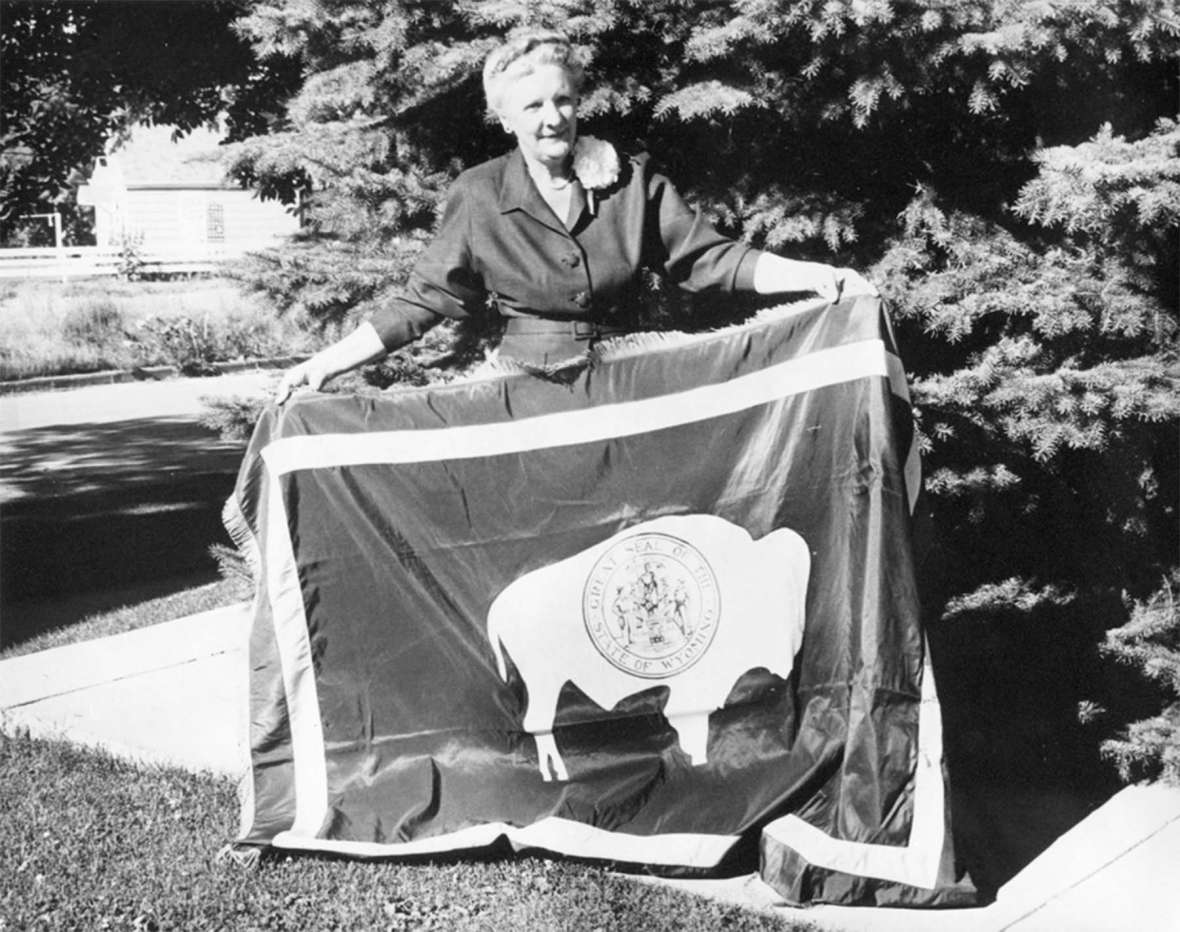
A lasting legacy
Verna would continue to sell flags until at least 1931, when she received the last saved correpsondence from the Lauterer Company. That same year she would move home to Buffalo with her two daughters, while Arthur stayed in Casper to save his business during the Great Depression. In the early 1930’s Verna organized the first Girl Scout troop and scouting camping activities in the nearby Bighorn Mountains, which she then expanded to other areas of Wyoming.
Hebard also struggled during the Depression. Though earning considerable money throughout her career, she spent much of that money on the uplifting of Wyoming, or on her students. All of the honorary flags given to Daley, Kendrick, Carey and Ross were purchased by Hebard. After several surgeries and a long battle with cancer, Hebard at the start of 1936 began to get her affairs in order—setting up scholarship funds and writing her thanks to the people she had worked with over the years. Writing to Verna in February of that year she reminisced, “Those were wonderful days, were they not, Verna, when we were working hard to get a flag and I little thought we could get anything so lasting and satisfactory. For this I am very grateful indeed and give myself the pleasure of again thanking you for it.” Grace Raymond Hebard passed away October that year.
After Arthur’s businesses grew stronger in 1940, Verna and their two daughters moved back to Casper. Over the years, Verna volunteered with many community organizaions, and traveled the world after she was widowed in 1951. First officially honored by the State of Wyoming for her design of the state flag in 1945, Verna would go on to be celebrated at parades and rodeos, and honored by the Rotary Club and the D.A.R. For many years she spoke throughout Wyoming of her service and retold the history of the flag to school groups, scout troops, and at the annual American Legion Girls State and Boys State events. Passing away in 1982, Verna left behind a legacy of humble service that still inspires the many who heard her speak or served alongside her to this day.
Verna remained attached to her original design for the rest of her life as evidenced in the photos taken of her holding the flag as she originally designed in 1916, as well as, the memories of those who knew her. Still, Verna always honored Hebard, including her whenever Verna recounted the history of the flag. For Verna it had become clear that there would have been no Wyoming State Flag without Grace Raymond Hebard.
Verna's speech notes reveal that she included a brief biography of Hebard coming to the state in most of her retellings of the flag’s history. Hebard had faced a similar realization in her lifetime, when she struggled to find a suitable manufacturer or someone to recreate a pattern—Hebard knew that establishing the flag required the artistic skill and knowledge of the designer herself, Verna Keays Keyes. The Wyoming State Flag flying today isn’t there because of a law or a contest—it flies because the dedication of both women was as tireless as the Wyoming winds.
Special thanks from the author and editors to Verna Keays Keyes’s granddaughter Rebecca Keays for sharing family history and insights, documents, letters, and artifacts while working since 2016 to help expand awareness and education about her grandmother in Wyoming and elsewhere. Rebecca is a Verna Keays Keyes historian, researcher, and archivist. Her current Verna projects include a book and website about Verna; creating a catalogue of all the known artifacts related to Verna and the Wyoming State Flag. An updated new Zoom recording of her 2021 Casper College Humanities Festival presentation about Verna will be available soon on the “Verna” website and in other venues.
Resources
Primary Sources
- Anderson, Eunice G. Biennial Report of the State Historian of the State of Wyoming for the Period Ending Sept. 30, 1920, with Wyoming Historical Collections. United States: State Historian, 1920, accessed
- Bailey’s School House Catalogues, Casper College Western History Center, Casper, Wyo. (Hereafter CCWHC)
- Clark, Edith K.O. Diaries 1904-1936. 1917 National Date Book, Edith K.O. Clark Diaries. American Heritage Center, University of Wyoming Laramie, Wyo (Hereafter AHC)
- Correspondence concerning the Wyoming State Flag can be found in both the Verna Keyes Papers and the Grace Raymond Hebard Papers, AHC, and in the Rebecca Keays Collection.
- Grace Raymond Hebard Papers. Verna’s undated response to Hebard’s letter dated July 1, 1925 (see next-to-last listing under Keyes Papers), Box 25, Folder 13; Oct. 19, 1925, Hebard to Harold Symons, Box 27, Folder 6; Oct. 29, 1925, Hebard to Verna, Box 25, Folder 13, AHC.
- Rebecca Keays Collection. Feb. 10, 1936, Hebard to Verna,, original at the Jim Gatchell Memorial Museum, Buffalo, Wyo.
- Verna Keyes Papers. Quoted Letters in order: Feb. 2, 1967, Verna to Katherine Halverson, Box 1, Folder 34; May 3, 1917 ,Hebard to John T. Hawkes, Box 1, Folder 1; May 3, 1917, Hebard to Verna, Box 1, Folder 1; Annotated Flag Cards, Box 1, Folder 2; May 23, 1949, Verna to Ellen Crowley, Box 1, Folder 8; Dec. 7, 1918, Hebard to Verna, Box 1, Folder 1; Feb. 25, 1919, annotated letter from Hebard to Verna with Mina Carr response and archival note, Box 1, Folder 14; July 1, 1925, Hebard to Verna, Box 1, Folder 1; Hebard to Verna, Feb. 2, 1926, Box 1, Folder 1, AHC.
- Keyes, Verna Keays. The Origin of the Wyoming State Flag, 15 February 1960. Limited edition broadside, 17” x 13”. One of Verna’s original 1960 broadsides is on display at the Natrona County Library, Casper, Wyo.
Wyoming Newspapers, accessed May 2017-June 2021 at http://wyomingnewspapers.org:
- The Laramie Republican, Sept. 6, 1916, p. 3
- Rock Springs Rocket, Sept. 15, 1916, p. 1
- Sheridan Enterprise, Sept. 8, 1916, p. 5
- The Wheatland Times, Sept. 13, 1916, p. 1
- The Wyoming Student, Sept. 27, 1916, p. 1
- The Wyoming Times, Sept. 14, 1916, p. 1
- Cheyenne State Leader, Jan. 19, 1919, p. 5
- Later newspaper clippings found in the Wyoming State Flag Folder at the CCWHC.
- Wyoming State Legislature. The Journal of the House of Representatives of the Fourteenth State Legislature of Wyoming. Jan. 9-Feb. 17, 1917, accessed August 25, 2021 at https://www.google.com/books/edition/House_Journal_of_the_State_Legislature_o/OWAlAQAAIAAJ?hl=en.
- __________________________. Session Laws of the State of Wyoming Passed by the Fifteenth State Legislature, 1919, accessed August 25, 2021 at https://www.google.com/books/edition/Session_Laws_of_the_State_of_Wyoming_Pas/IsU4AAAAIAAJ?hl=en&gbpv=0.
- __________________________. Session Laws of the State of Wyoming Passed by the Nineteenth State Legislature, 1927, accessed August 25, 2021 at https://hdl.handle.net/2027/uc1.b3831085.
- __________________________. Session Laws of the State of Wyoming Passed by the Twenty-Eighth State Legislature, 1945, accessed August 25, 2021 at https://hdl.handle.net/2027/uc1.b3831094.
Secondary Sources
- Newell, Priscilla Keyes. “Verna Keays, Wyoming’s Flag Designer,” Annals of Wyoming 71, no. 1 (Winter 1999): 2-9, accessed July 1, 2021 at https://archive.org/details/annalsofwyom71141999wyom/page/n1/mode/2up.
- Van Nuys, Frank. "My One Hobby: Grace Raymond Hebard and Americanization in Wyoming," Wyoming History Journal 67 (Autumn 1995) accessed August 25, 2021 at https://wyomingalmanac.com/?p=923.
- Warner, Ryan. “Like the Green Triangle Logo, Colorado’s Original State Flag was a Bust.” Colorado Public Radio (March 27, 2019): https://www.cpr.org/show-segment/like-the-green-triangle-logo-colorados-original-state-flag-was-a-bust/.
Illustrations
- The 1930 photo of Grace Hebard holding the flag, and the two postcards showing the dueling flag design are from the collections of the American Heritage Center at the University of Wyoming. Used with permission and thanks. The photo of the two postcards is by the author. Used with permission and thanks.
- The 1935 photo of state officials with the flag, the 1940s photo of Sen. O’Mahoney and staffers with the flag and the photo of Verna Keays Keyes with the flag are all from Wyoming State Archives. Used with permission and thanks.
- The color photo of the flag is from Wikipedia. Used with thanks.
Early versions of the Wyoming State Flag
Some early and important versions of the Wyoming State Flag may be seen at the field trip locations.
